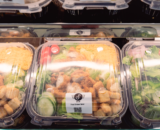The Food and Drug Administration has released non-binding guidance on the menu labeling regulations that are currently scheduled to take effect in May 2018. The regulations apply to restaurants, convenience stores, and supermarkets with 20 or more locations. As a general matter, the guidance document provides little additional clarification and underscores the need for legislation to lessen the unnecessary burdens that certain convenience stores and restaurant models will face under the new rules.
NATSO's primary concerns with the menu labeling regulations, as detailed in its recent comments to FDA on this topic are that the rule places many restaurants and convenience stores in the travel center industry at a competitive disadvantage relative to traditional chain restaurants. The regulations do this in several ways, including by requiring establishments to include calorie labels for food items that are only offered at one or two locations within a chain, and by requiring that calorie labels be visible to customers at the moment they make their order selection (as opposed, for example, to being located at the head of a buffet table, or on a large menu board behind the counter in a convenience store).
The guidance, which can be read in its entirety here, does not provide any relief from these concerns. Instead, it essentially amounts to reiterating the regulatory requirements as they were already widely understood (and detailed more completely in NATSO's member-only compliance guide). Given that FDA has indicated that it intends to maintain the current May 2018 compliance date for the regulations, NATSO strongly urges Congress to adopt H.R. 772, legislation introduced by Cathy McMorris Rodgers (R-WA) that would revise the requirements that so that: (i) retailers would be allowed to post all of the nutrition information on a single menu board; (ii) would not be liable for natural calorie and nutrition variations in foods, and would eliminate unreasonable penalties so that retailers would not be subject to frivolous lawsuits for good faith efforts to comply with the regulations.
Below is a brief overview of those aspects of the recently released guidance document that are most helpful / relevant for NATSO members:
1) Section 3 -- Includes details on calorie disclosure requirements for self-service foods, including buffet foods.
2) Section 4.1 -- Clarifies the distinction between "marketing materials" (not subject to calorie disclosure requirements") and "menus" (which are subject to calorie disclosure requirements): "Written material of an establishment that does not satisfy the criteria of a primary writing from which a customer makes an order selection, such as a poster on a storefront, a coupon, or other promotional material, banners, billboards, and stanchions, would be considered a “secondary writing” of an establishment. If the primary purpose of these materials is to “entice” customers into the covered establishment, then we would not consider them to be a primary writing, and they would not require calorie declarations." (Emphasis added.)
3) Section 6.2 -- Addresses enforcement of the regulations, clarifying that FDA does not intend to penalize retailers for "minor" or "inadvertent" violations (while maintaining that criminal penalties remain possible for other violations).
4) Sections 7.1-7.4 -- Outlines the manner in which retailers can permissibly determine calorie content for standard menu items.
5) Sections 8.2 -- States that a retailer that sells motor fuel under a brand name, but operates a convenience store under a different name, is not necessarily covered by virtue of the fuel brand being part of a "chain" with 20 or more locations; rather, the name of the convenience store is the key factor. (The guidance does appear, however, to indicate that if there is no unique name to the convenience store, the fuel brand may in fact subject that store to the menu labeling requirements.)
6) Section 9 -- States that food items that are not sold in more than 20 locations but are standard menu items at one or more locations part of that particular chain are subject to the requirements, but further clarifying that menu items that are not "routinely offered" at establishments (i.e., offered fewer than 60 days per year or items that are offered for fewer than 90 consecutive days as part of a consumer acceptance test) are not subject to the rules.
Subscribe to Updates
NATSO provides a breadth of information created to strengthen travel plazas’ ability to meet the needs of the travelling public in an age of disruption. This includes knowledge filled blog posts, articles and publications. If you would like to receive a digest of blog post and articles directly in your inbox, please provide your name, email and the frequency of the updates you want to receive the email digest.

